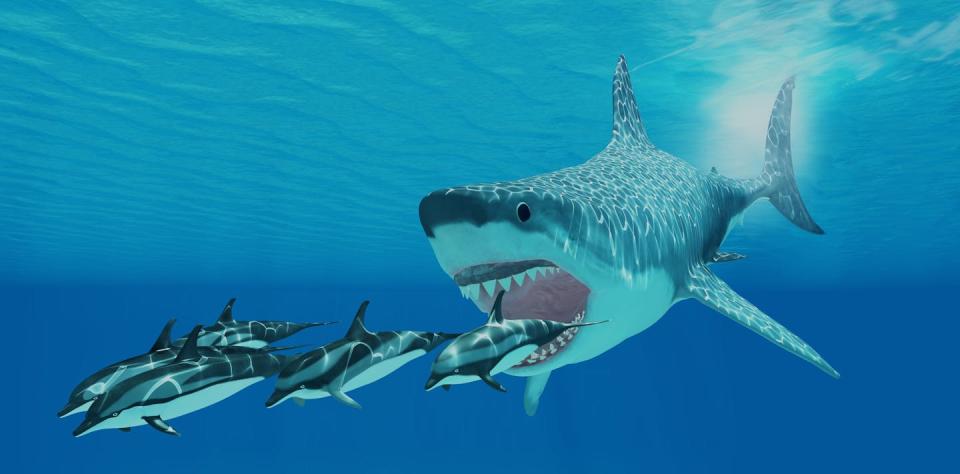
Curious Kids is a series for children of all ages. If you have a question you’d like an expert to answer, send it to curiouskidsus@theconversation.com.
When did the megalodon shark become extinct, and why? – Landon, 10 years old
Imagine traveling back in time and looking at the oceans of 5 million years ago.
As you stand on an ancient shore, you see several small whales in the distance, wandering on the surface of an ancient sea.
Suddenly, and without warning, a huge creature erupts from the depths.
With its huge jaws, the monster crushes one of the whales and drags it down into the depths. Large chunks of the body are ripped off and swallowed whole. The rest of the whales disperse.
You have just witnessed mealtime for a megalodon – formally known Otodus megalodon – the biggest shark ever.


About the megalodon
As a scientist who studies sharks and other ocean species, I am fascinated by the terrifying marine predators that have appeared and disappeared through the oceans.
This includes giant swimming reptiles such as ichthyosaurs, plesiosaurs and the mosasaurs. These incredible predators lived during the time of the dinosaurs; megalodon would not appear for another 50 million years.
But when it arrived on the scene, about 15 million to 20 million years ago, the megalodon must have been an incredible sight.
A fully grown individual weighed about 50 metric tons – that’s more than 110,000 pounds (50,000 kilograms) – and was 50 to 60 feet long (15 to 18 meters). This animal was longer than a school bus and as heavy as a railway car!
Its jaws were up to 10 feet (3 meters) wide, the teeth up to 7 inches (17.8 centimeters) long and the bite force was 40,000 pounds per square inch (2,800 kilograms per square centimeter) .
Not surprisingly, megalodons ate large prey. Scientists know this because megalodon tooth chips are embedded in the bones of large marine animals. On the menu, together with whales: big fish, seals, sea lions, dolphins and other sharks.


Are scientists sure that megalodon is extinct?
There are still internet rumors that megalodons exist today – that they are still swimming around in today’s oceans.
But that is not true. Megalodon is extinct. They died out about 3.5 million years ago.
And scientists know this because, again, they looked at the teeth. All sharks – including megalodons – produce thousands of teeth in their lifetime.
That means many of those lost megalodon teeth are still around as fossils. Some are found at the bottom of the ocean; others washed up on the shore.
But no one has found a megalodon tooth that is less than 3.5 million years old. That’s one of the reasons scientists believe megalodon went extinct there.
In addition, megalodons spent much of their time relatively close to shore, where they easily found prey.
So if megalodons were still around, people would definitely have seen them. They were too big to miss; we would have lots of photos and videos.
Why megalodon disappeared
It is likely that this great megalomaniac was not one thing, but a complex combination of challenges.
First, the climate changed dramatically. Global water temperatures fell; which reduced the area where megalodon, a warm water shark, could thrive.
Secondly, due to climate change, the entire species that megalodon preyed on disappeared forever.
At the same time, competitors helped push the megalodon to extinction – including the great white shark. Although they were only one-third the size of megalodons, the great whites likely ate some of the same prey.
Then there were killer sperm whales, a type of sperm whale that is now extinct. They grew to the size of a megalodon and had even bigger teeth. They were also warmblooded; This meant that they enjoyed an extended habitat, as living in cold waters was not a problem.
Killer sperm whales probably traveled in groups, so they had an advantage when they encountered megalodon, which probably hunted alone.
The cooling seas, the disappearance of the prey and the competition – it was too much for the megalodon.
And that’s why you won’t find a megalodon tooth today.
Hello, strange children! Have a question you’d like an expert to answer? Ask an adult to send your question to CuriousKidsUS@theconversation.com. Please tell us your name, age and the city where you live.
And since curiosity has no age limit – adults, let us know what you think too. We won’t be able to answer every question, but we’ll do our best.
This article is republished from The Conversation, a non-profit, independent news organization that brings you reliable facts and analysis to help you make sense of our complex world. It was written by: Michael Heithaus, Florida International University
Read more:
Michael Heithaus does not work for any company or organization that would benefit from this article, does not consult with, own shares in or is funded by any company or organization that would benefit from this article, and has disclosed no affiliations relevant beyond his academic appointment.